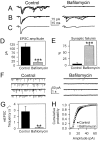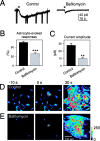SNARE protein-dependent glutamate release from astrocytes
- PMID: 10632596
- PMCID: PMC6772413
- DOI: 10.1523/JNEUROSCI.20-02-00666.2000
SNARE protein-dependent glutamate release from astrocytes
Abstract
We investigated the cellular mechanisms underlying the Ca(2+)-dependent release of glutamate from cultured astrocytes isolated from rat hippocampus. Using Ca(2+) imaging and electrophysiological techniques, we analyzed the effects of disrupting astrocytic vesicle proteins on the ability of astrocytes to release glutamate and to cause neuronal electrophysiological responses, i.e., a slow inward current (SIC) and/or an increase in the frequency of miniature synaptic currents. We found that the Ca(2+)-dependent glutamate release from astrocytes is not caused by the reverse operation of glutamate transporters, because the astrocyte-induced glutamate-mediated responses in neurons were affected neither by inhibitors of glutamate transporters (beta-threo-hydroxyaspartate, dihydrokainate, and L-trans-pyrrolidine-2,4-dicarboxylate) nor by replacement of extracellular sodium with lithium. We show that Ca(2+)-dependent glutamate release from astrocytes requires an electrochemical gradient necessary for glutamate uptake in vesicles, because bafilomycin A(1), a vacuolar-type H(+)-ATPase inhibitor, reduced glutamate release from astrocytes. Injection of astrocytes with the light chain of the neurotoxin Botulinum B that selectively cleaves the vesicle-associated SNARE protein synaptobrevin inhibited the astrocyte-induced glutamate response in neurons. Therefore, the Ca(2+)-dependent glutamate release from astrocytes is a SNARE protein-dependent process that requires the presence of functional vesicle-associated proteins, suggesting that astrocytes store glutamate in vesicles and that it is released through an exocytotic pathway.
Figures





References
-
- Ahnert-Hilger G, Bigalke H. Molecular aspects of tetanus and botulinum neurotoxin poisoning. Prog Neurobiol. 1995;46:83–96. - PubMed
-
- Araque A, Parpura V, Sanzgiri RP, Haydon PG. Glutamate-dependent astrocyte modulation of synaptic transmission between cultured hippocampal neurons. Eur J Neurosci. 1998a;10:2129–2142. - PubMed
-
- Araque A, Parpura V, Sanzgiri RP, Haydon PG. Tripartite synapses: glia, the unacknowledged partner. Trends Neurosci. 1999a;22:208–215. - PubMed
-
- Araque A, Sanzgiri RP, Parpura V, Haydon PG. Astrocyte-induced modulation of synaptic transmission. Can J Physiol Pharmacol. 1999b;77:699–706. - PubMed
Publication types
MeSH terms
Substances
Grants and funding
LinkOut - more resources
Full Text Sources
Miscellaneous
